|

On eBay Now...
VINTAGE ROBINSON\'S EMPLOYEE BADGE / PIN For Sale

When you click on links to various merchants on this site and make a purchase, this can result in this site earning a commission. Affiliate programs and affiliations include, but are not limited to, the eBay Partner Network.

VINTAGE ROBINSON\'S EMPLOYEE BADGE / PIN:
$20.00
VINTAGE ROBINSON\'S EMPLOYEE BADGE
2-3/4 X 1-5/8, pin working as designed.
Conditon:Very good vintage condition with minor wear from honest use.
From the Department Store Museum online:
Joseph Winchester Robinson left Waltham, Massachusetts, where he had operated a dry goods business, for California in 1882. Intending to develop orange groves in Riverside, California, the 36-year old Robinson instead took an interest in the retail business in the small, 13,000-strong community of Los Angeles. Sensing that the area would grow, and that the rough-and-tumble general stores of the day were doing a poor job of serving the public, he quickly returned to the east coast, and used his contacts in the dry goods business to have merchandise shipped around Cape Horn to the new store he planned to open in Los Angeles.
The “Boston Dry Goods Store”began businessin February of 1883 at the corner of N. Spring and Temple Streets. He advertised that hisestablishment was characterized by “fine stocks and refined ‘Boston’ service.” The arrival of railroads spurred the enormous and long-lived growth of Southern California, and Robinson’s store brought eastern goods and their attendant sophistication to a willing (and growing) public; in 1887 the store was forced to move to larger quarters at 69-73 N. Spring Street. After returning from a trip back east in 1891, Robinson became ill and passed away in his home at the age of 45. At the time of his death, his employees published a resolution stating that “We of the Boston Store sadly realize that a good man has gone – a man of sterling integrity, of great energy, and of large public spirit.” His father, H.W. Robinson came to Los Angeles for the funeral and to look after the business founded by his late son.
Remaining under family control, the store was renamed J.W. Robinson Co. (but continued to trade as the “Boston Dry Goods Store” until after the turn of the century) and moved in 1896 to 239 S. Broadway, “opposite City Hall.” In the early days of the twentieth century, the Los Angeles area grew and grew, especially with the arrival of the film industry. The store, which “catered to the most exclusive trade” according to the Los Angeles Times in 1911, expanded into adjacent properties, but it became apparent to management that the South Broadway location could not handle the store’s growth into the future. Accordingly, land was acquired along Seventh Street between Grand and Hope streets, at the time beyond the limits of Los Angeles’ central business district.
By 1914, the site, with 333 feet of frontage on Seventh Street, and 135 feet each on Grand and Hope Streets, was being excavated for the J.W. Robinson Co.’s new store of 392,000 square feet. When it opened in September of 1915, the seven-story building of beige pressed brick, trimmed in cream and polychrome terracotta, was described in the press as “a retail palace” with “all the conveniences and attractions of a great club and meeting place.” The distinctive building with its corner towers, deeply projecting cornices, and oculus windows featured 10 passenger elevators for vertical conveyance, and two roof gardens on either side of a seventh-floor dining room approached through a foyer “arranged as a palm room.”
When the new store was announced, some voices raised criticism over its out-of-the-way location, but by the time it opened, and as it became established along Seventh Street, it helped to establish a high-class shopping district. Robinson’s prosperity at Seventh and Grand was such that a seven-story addition to the south was constructed in 1923, bringing the store’s square footage up to 624,000 sq. ft.
Robinson’s modernized the interior of its flagship store in the depression years from 1931 to 1933, and the Los Angeles Times noted that the store’s plan to modernize its exterior coinciding with its 51st anniversary in 1934 “marked the third time in its history that the J.W. Robinson Co. expressed confidence by expanding in periods of world stress.” The paper also noted the store’s growth in human terms – its two employees had grown to 1500 at the time.The new exterior, unveiled on September 3rd, 1934, was a mixture of sleek art-deco design mixed with oversize classical detailing executed in reinforced concrete and stucco designed by the architect Edward L. Mayberry. The Times called it “one of the outstanding beautiful structures of America,” and the store referred to it as a “restrained-modernistic design.”
In the ensuing years, the company resisted the outward expansion begun by competitor Bullock’s in the late 1920’s with its stunning Wilshire branch, and settled into its role as one of Los Angeles’ most exclusive and respected stores, which embodied the “fair dealing, honest values, and a stock of merchandise that was the best available” characteristic of J.W. Robinson’s philosophy for his store. For many customers, Robinson\'s distinctive \"signature\" logo, whether it appeared on bags, boxes, or on the later branch stores, itself indicated status, quality and distinction. While it was known as a sumptuous luxury store, Robinson\'s, like many similar retailers, carried merchandise in a variety of price ranges. It coined the name \"Robinaire\" for its lower price ladies\' wear departments, and paid homage to its home state in its \"Young California\" shops for young women.
Robinson’s began postwar expansion somewhat tentatively, first opening a seasonal resort branch in Palm Springs’ Desert Inn in 1947. In 1952, Robinson’s unveiled its first major branch store in Beverly Hills, designed by Charles Luckman and William Pereira, with interiors by Raymond Loewy. The mid-century modern store, with floor-to-ceiling windows looking out on a “California Patio” had adjacent parking and a rooftop restaurant, and was noted by the Los Angeles Times for its \"striking architecture and sophisticated smartness.\"
Further branch development followed, with two stores, in Pasadena and Palm Springs, opening in Robinson’s 75th anniversary year of 1958. The latter store was a tiny jewel set in the desert, with a hovering folded-plate roof and extensive use of glass curtain walls. More conventional, but still top-of-the-line branch stores opened in the 1960s in the San Fernando Valley and Anaheim.The trio of late 1960s stores located in Santa Barbara, Newport Beach, and San Diego took innovation even further, wholly rejecting the “department-store-as-box” concept, and housing Robinson’s in a highly sculptural composition of cantileveredmasses, interspersed with tile-roofed colonnades and a bell-tower and carillon as a focal point. Later branches were smaller and simpler versions of this quintessential Robinson’s style, although the 1974 Woodland Hills branch repeated the concept in totality.
Robinson’s food service in its flagship store included the aforementioned roof-top tearoom, which was remodeled in 1955 and renamed The California Room. In 1954, a quick-service restaurant was built on the seventh floor and named The Round Robin, playing on its circular design reminiscent of a birdcage, and the store’s name as well. The California Room and Round Robin were exported to several of the branch stores as well. The downtown store also had a “Sidewalk Coffee Corner” for light snacks.
Robinson’s became a part of the Associated Dry Goods chain headquartered in New York. The store was Associated’s first affiliate on the West Coast, and the store stated at the time of the takeover that the decision to sell to a national chain was done to protect the business (from estate taxation among other things) for the family which still ran it, and Associated made clear at the time that it had “no intention of interfering in any way with stores that have so completely endeared themselves to their public.” Indeed, Robinson’s thrived in its role as a well-loved and respected carriage-trade retailer well through the 1970s.
EpilogueEven when downtown Los Angeles declined as a retail magnet, Robinson’s did well enough to warrant a major remodeling of the flagship store in the early 1980s, and the company continued branch expansion, notably opening a store in downtown San Diego’s Horton Plaza.
The parent company, Associated Dry Goods, was, however, suffering, and was taken over by The May Co. in 1986. May folded its Arizona-based Goldwater’s division into Robinson’s in 1989 and by 1992 decided to consolidate its Los Angeles May Co. stores with Robinson’s. The resulting, awkwardly-named Robinson’s-May division was in reality more of a expanded May Company than a store which reflected the heritage of luxury of its older namesake.
Remnants of Robinson’s as a bastion of the retail trade had been obliterated by the time that May department stores was bought by rival Federated department stores; several of the original buildings do survive intact as current Macy’s or Bloomingdale’s stores; the great and beautiful flagship store at 600 W. Seventh Street in Los Angeles closed in 1991, and today houses offices and a drug store.


Vintage wood, paper label Robinson’s Scotch Sachet bottles in wooden box. $13.20
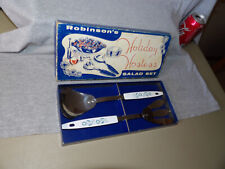
Vintage Robinson's Blue Cornflower Holiday Hostess Salad Set VGC $49.99
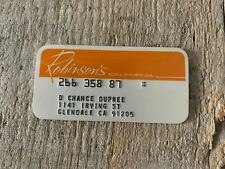
Robinson's California Charge Card Vintage Princess Size $9.62
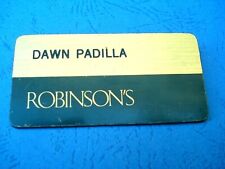
VINTAGE ROBINSON'S EMPLOYEE BADGE / PIN $20.00
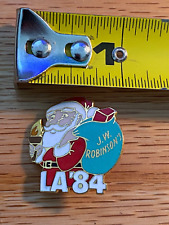
Vintage J.W. ROBINSON'S Department Store Santa Claus 1984 1" Olympics Pin $7.75

Vintage Robinson Stainless Slotted Spatula 11” Short Wood Handle $34.00
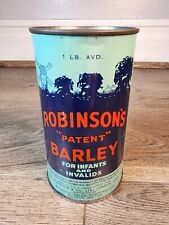
Vintage Robinson's Patent Barley For Infants & Invalids 1 Lb Unopened Full Can $59.95
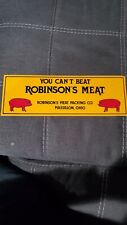
VINTAGE EMBOSSED ROBINSON'S MEAT PACKING CO.TIN SIGN $99.00
|